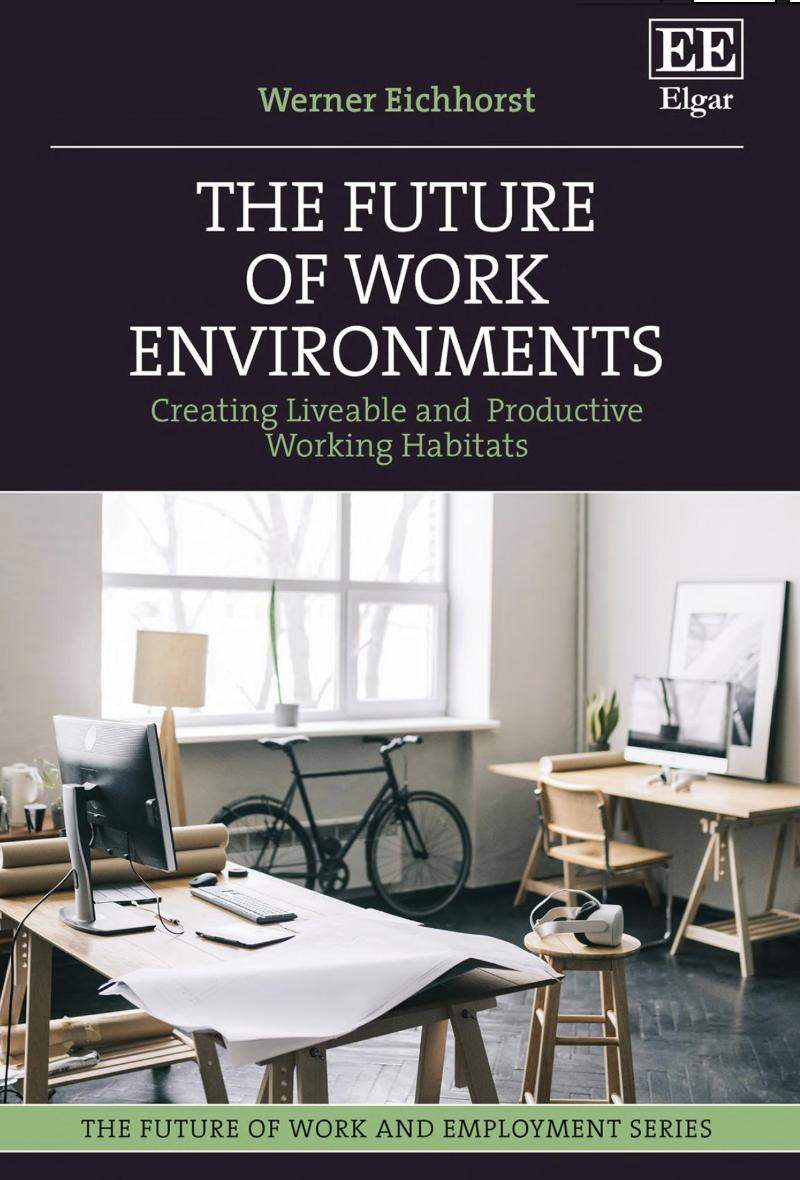In a new book, The Future of Work Environments, Werner Eichhorst provides a comprehensive overview of the role of work, addressing a fundamental issue in any research or policy debate related to work: how to improve working conditions so that individuals can flourish both on the job and in their private lives, thereby contributing to thriving societies and economies.
Back to the future (of work)
The Future of Work Environments takes a long-term view, placing the present day on a nearly century-old sine curve of social and economic changes that have led us to our current situation. In so doing, it encourages us to pay attention to continuities, which are often ignored in favour of more dramatic, momentous changes in work realities. At the centre of analysis lies the complex and constantly contested boundary between work and non-work, attaching particular importance to the dimensions of time and place. Performance of work comes with its difficulties, but so does not working; it becomes increasingly difficult to disconnect from work, literally because of connected digital work tools following workers into their private spheres of life, but also mentally.
Centering mental exhaustion at work helps foreground the transformations of knowledge-based work that still remain under-researched and insufficiently documented. One of the key developments is the ever-increasing importance attached to measurable targets and performance indicators (also known as ‘KPIs’). Problems arise in the knowledge economy, where work that requires innovative and creative thinking – including academic research and theorising – produces outputs that, unlike physical goods coming out of a factory or workshop, cannot be so easily measured. This sobering account may sound all too familiar to readers, especially in academia, who are themselves struggling to compartmentalise their work into targets and deliverables. Forcing creative and knowledge work into Excel sheets and numeric indicators risks stifling the development of new ideas and allowing numbers to dominate substance.
The book identifies one driving force behind these developments: digitalisation. In particular, when algorithmic management is introduced to direct work, rapid technological advancement translates into an increasing standardisation of tasks and schedules. The computational capacity of new technologies is astounding, but it necessitates the transformation of the labour process into a series of data points. The actual process of working is devalued by such measurement. It extends oversight and reconfigures the balance of power between workers and employers, while also allowing tech providers to emerge as the new rulers. By highlighting and analysing such risks using various examples and contexts, the book provides a much-needed guide to navigating this technological transformation and formulating policies and regulations suited to the era of radical digital advancements.

The Future of Work Environments by Werner Eichhorst (2025, Edward Elgar Publishing)
Technological progress does not mean social progress
This account may resonate particularly with the knowledge economy, office-based workers, or white-collar jobs — a focus that likely stems from the author’s own rich first-hand experience and observations. Spotlighting these experiences can evoke nostalgia for a ‘bygone golden era’ of the manufacturing sector, when people did meaningful work producing tangible and useful goods, and the separation between work and private life was a natural consequence of working conditions.
While the perception of the past as more favourable is a common occurrence, it is interesting to delve deeper into sources of this nostalgia. One might argue that a factory is not necessarily connoted as a comfortable or safe workplace. This is true today and was even more so in the past. Many occupational health and safety standards emerged in response to hazardous manufacturing environments, while trade union campaigns and intense worker protest in industrial settings highlighted the dehumanising nature of work organisation and unsustainably long working hours. The positive image of employment in the manufacturing sector during its boom period can be then attributed to the job and income security it offered.
This raises an important question of whether the employment standards as once seen in manufacturing – including relatively secure contracts that provide access to workers’ rights and collective representation – can be expected in today’s service sector and knowledge-based economy. Here I disagree with Eichorst, who proposes that such forms of standard employment are still the dominant form of work (at least in continental Europe, which is the main point of reference in the book). Instead, the author’s former line of argument is more accurate in asserting that today’s world of work already resembles a vast digital labour platform, with downward pressure on quality of work and wages realised through ever-longer value chains.
Previous research sheds some light on this presumed conundrum. For instance, the wave of deregulation following the 2008 financial crisis in Europe stripped permanent and full-time contracts of much of their significance in terms of protection and predictability they used to offer. The labour market is more complex than a dual division into its core and periphery may suggest. Inequalities are in fact constructed by employers through policies and practices, both formal and informal, with supply-side factors like gender, race or a history of precarious work playing a role too.
What policy options?
What futures of work are possible? Using the ideal-typical approach, Eichhorst presents the reader with two imagined extremes of where the current period of transformations can lead us. On the one hand, there is a vision of a dystopian vertical capitalism, where technology exacerbates power imbalances, work is closely monitored, and individuals’ skills and the meaning of their work are depleted rather than enriched. At the other extreme, there is a more egalitarian, horizontal capitalism with a virtuous circle between technological progress and the enrichment of human labour. In this latter scenario, workers thrive while working alongside and in synergy with machines. Technology complements rather than replaces or endangers human labour and the meaning of work, while workers capitalise on their uniquely human abilities.
While the choice between these two futures is supposedly clear, the path to achieving the desired outcome is less obvious. Among the most notable progressive proposals of our time are policies such as reducing working hours, introducing a universal and unconditional basic income, strengthening employment protection to bring it in line with the quality of the standard employment relationship, reviving social partnership, or overhauling capitalism altogether with an alternative economic and political model of production and distribution. Critical engagement with these ideas leads us to reflect that no single policy option is capable of providing the necessary or viable answers to the complex web of current challenges.
Rather than resignation, The Future of Work Environments invites us to explore and envisage other possible pathways forward. An alternative approach to creating more humane work environments would draw on elements of the Nordic flexicurity model, coupled with strong collective bargaining and worker participation, similar to those of Workers’ Councils in Germany. Looking towards these elements and models invites discussion on management styles and job crafting, which should be carried out by workers themselves within their unique occupational niches and at the intersection of work and private life. While it may not be practicable or achievable for all workers under current conditions, it makes for an attractive vision nonetheless.
This essay is based on a book review by the same author
published originally in German at sozialpolitikblog: Zurück in die Zukunft der Arbeit
Header photo by Nastuh Abootalebi - Unsplash








